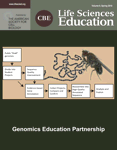Different but Equal? How Nonmajors and Majors Approach and Learn Genetics
Abstract
Introductory biology courses are frequently offered separately to biology majors and nonbiology majors, with the assumption that the two groups of students are different enough to merit different courses. To assess the evidence behind this assumption, we compared students in two different genetics classes at the University of Colorado–Boulder, one class for nonscience majors (nonmajors) and the other class for biology majors and students planning a biology-related career (majors), to see whether these two groups of students were fundamentally different in performance and attitudes. To measure content knowledge, we administered identical assessments to both groups of students during the semester: a validated pre- and postcontent assessment (Genetics Concept Assessment), ungraded quizzes after problem-solving sessions, and questions on each exam. We measured attitudes, study time, and study techniques through online surveys. Majors outperformed nonmajors on content assessments, finishing with significantly higher learning gains. Nonmajors and majors also differed in their motivation, interest, study time, and expert-level of beliefs. We suggest that focusing on the process of science and its connection to students' lives will better engage and motivate nonmajors while still helping them learn the fundamental concepts of genetics.
INTRODUCTION
Biology instructors often assume that nonscience majors are fundamentally different from science majors in their background knowledge, their approaches to biology classes, and their attitudes about biology. Accordingly, many universities offer different classes for their majors and nonmajors. Compared with courses for majors, courses for nonmajors tend to offer a low level of scientific/discipline-specific literacy and are usually stand-alone courses (Klymkowsky, 2005). Because a nonmajors course may be the only college course where a student is exposed to biology, the needs of nonmajors (e.g., basic scientific literacy and connection to everyday life) may be fundamentally different from the needs of majors (e.g., a foundation of important biological concepts that they will build on over the course of their education; Wright, 2005). Although only a few studies to date have compared the performance of nonmajors to majors in biology courses, these studies have generally found that nonmajors have the ability to perform well in biology classes and that they may be particularly responsive to interactive techniques. For example, Sundberg and colleagues (Sundberg and Dini, 1993; Sundberg et al., 1994) showed that the performance of nonbiology majors in introductory biology courses could equal and sometimes exceed the performance of majors on identical content assessments. In these studies, the nonmajors and majors courses were taught by different instructors, and the nonmajors courses had a more conceptual approach, including emphasis on historical context and the connection of science to society. Ernst and Colthorpe (2007) demonstrated in a physiology course that both science and nonscience majors benefited from the addition of interactive techniques such as in-class group activities. Notably, nonscience majors in this study made significantly greater gains than science majors when comparing performance on similar but nonidentical exam questions in a semester without interactive techniques to a semester with interactive techniques. Another recent study examined whether in-class clicker questions affected retention of course material (Crossgrove and Curran, 2008). The authors compared student performance 4 mo after the end of the class on questions covering concepts previously tested with in-class clicker questions and concepts not tested in class. For nonmajors, they found that retention was higher on concepts tested with in-class clicker questions, but for majors, the retention was the same in both conditions. However, in this study, there was a small sample size of self-selected students (7% nonmajors; 32% majors), and the retention questions were not matched in their conceptual difficulty.
Another set of studies investigated the correlation between attitude and performance among nonscience and science majors, both in terms of self-efficacy (confidence in understanding and using science) and epistemological views of science (the nature of knowing about science and understanding how science is “done”). Baldwin et al. (1999), who developed a Biology Self-Efficacy Scale to measure the effects of different active-learning techniques on self-efficacy in nonbiology majors, and Fencl and Scheel (2005), who used a similar tool to measure self-efficacy among nonphysics majors taking physics, both found that active-learning techniques such as in-class group work and problem solving increased self-efficacy. Sundberg and Dini (1993) and Sundberg et al. (1994) also looked at the changes in attitude toward biology in their aforementioned studies of students in introductory biology classes by using an attitude assessment tool that they designed. They demonstrated that nonmajors became more comfortable with science and saw science as more connected to their everyday lives, whereas majors' beliefs became more negative on these topics after their course in introductory biology. However, using another attitudes and beliefs survey, the Colorado Learning Attitudes about Science Survey (CLASS) developed for physics (Adams et al., 2006), chemistry (Barbera et al., 2008), and now biology (in preparation), a different picture has emerged. This survey captures how students feel about learning, solving problems, and seeing a connection between science and their lives, among other topics. Student responses are then compared with the opinions of experts to “benchmark” where students stand along a scale of novice to expert beliefs and attitudes about science. Although instructors do not necessarily expect their students to be expert in their beliefs, the CLASS has been used to indicate where groups of students fall in this continuum. Data from the CLASS suggest that nonmajors generally both begin and end courses with less expert views about science compared with majors, both in chemistry and physics classes (Barbera et al., 2008; Gray et al., 2008). The different attitude instruments used, and the conflicting results from these studies, make it difficult to come to a consensus about how differences in attitudes might impact student performance when comparing nonmajors to majors.
Similarly to many other institutions, the University of Colorado–Boulder offers different biology courses to majors and nonmajors. In this article, we examine student performance and attitudes in two genetics courses, one for majors, the other for nonmajors. Because these two courses are similar in their approach and share a subset of learning goals, we were able to examine whether nonmajors can perform as well or better than majors on identical materials at several time points during the course. By taking multiple data points on student content knowledge during the semester, as well as using a pre- and postcontent assessment known as the Genetics Concept Assessment (GCA; Smith et al., 2008), we were able to measure the progression of student learning as well as the final outcomes. In addition, we administered several surveys throughout the semester to address three fundamental aspects of how students were engaging in learning genetics: their process (study habits and interactions with other students), their motivation and attitudes toward genetics, and their time spent studying. Contrary to some predictions from previous studies, we found that nonmajors, in comparison to majors 1) do not perform as well and do not continue to improve their understanding of topics as the course progresses; 2) are less motivated and interested, study less, and use less effective study techniques; and 3) begin and end their genetics course with less expert views about biology.
METHODS
The University of Colorado–Boulder majors and nonmajors genetics courses are fundamentally similar in their approach, but are separate for historical reasons. The nonmajors course was initiated over a decade ago at the request of the College of Arts and Sciences as a course that nonscience majors could take to fulfill part of their science distribution requirement. The majors course is the second course required of molecular, cellular, and developmental biology (MCDB) majors and is also taken by other science and engineering majors for future career preparation (e.g., medical school, graduate school). Students taking the majors genetics course have completed an introductory MCDB course that covers the basics of cell and molecular biology; both courses include units on the central dogma, but there is no additional content overlap.
Both the majors and the nonmajors courses met in the afternoon for three 50-min class periods per week. There were 72 students enrolled in the nonmajors course and 151 in the majors course. The same overall active-learning approach was used in both classes: lecture interspersed with three to five in-class concept questions per class period (answered with clickers for participation credit). Time was spent during each class period discussing answers to clicker questions, and students were encouraged to talk to each other and ask questions of the instructor. Both courses had regular online homework assignments worth 17% of their grade (majors had 11 and nonmajors had 8; see Supplemental Material A for homework problem examples). For majors, all homework problems were multiple-choice; for nonmajors, they were a mixture of multiple-choice and short answer (most commonly used to ask the students to describe their reasoning or make connections between topics). Both courses also had three exams (combination of multiple-choice and short answer) and a final. Answers to clicker questions and homework assignments were posted on the course websites, and both instructors encouraged students to use these as a study resource.
The majors and nonmajors courses share a subset of common content learning goals (Table 1). However, the nonmajors course covers less overall content, spending more time on each of the shared topics and not going into as much detail on those topics as does the majors course (Supplemental Material B). The nonmajors course has a purely human focus and uses almost exclusively human examples in homework and exam questions, whereas the majors course emphasizes human genetics, but also discusses model systems.
| Learning goal 1 | Deduce information about genes, alleles, and gene functions from analysis of genetic crosses and patterns of inheritance |
| Learning goal 2 | Describe the molecular anatomy of genes and genomes |
| Learning goal 3 | Describe the mechanisms by which an organism's genome is passed on to the next generation |
| Learning goal 4 | Compare different types of mutations and describe how each can affect genes and the corresponding mRNAs and proteins |
| Learning goal 5 | Interpret results from molecular analyses to determine the inheritance patterns and identities of human genes that can mutate to cause disease |
The nonmajors course was taught by one of us (Knight); the majors course was taught by a tenured professor whose research area is in human genetics. The faculty who taught the courses both have Ph.D.s in genetics-related fields, teach upper-level courses for majors in addition to teaching genetics, and have received comparable above-average student evaluations. The instructor of the majors course has been teaching for 20 yr but had only taught the majors genetics course once before. The instructor of the nonmajors course has been teaching for 10 yr and has taught this particular genetics course nine times. In the nonmajors course, one class period a week (Fridays) was devoted to group problem-solving rather than lecture, using materials developed by us to address difficult concepts discussed that week in class. For the problem-solving sessions, the nonmajors were split into groups of 15–20 students and met in different classrooms during these sessions where they worked in smaller groups of approximately four students. In the majors class, these same problem-solving activities were used in a separate group problem-solving session, called a “coseminar” in which students could voluntarily participate (for one credit, pass/fail). Forty-one percent of the students in the majors course participated in the coseminar, which was structured identically to the nonmajor Friday activities in both content and organization (small groups of students working together in small classrooms).
A subset of students in the coseminar majors course (67%) were coenrolled in a genetics laboratory course that met for 2 h per wk. The laboratory course is a separate course, taught by a different instructor, and covers different material from the coseminar problem-solving sessions (only overlap is for learning goal 3). The nonmajors course has no associated lab.
Content Knowledge
To measure content knowledge and learning gains, we examined performance on a series of shared multiple-choice questions. All questions were designed to test basic conceptual understanding of the five shared learning goals (Table 1) at a level that should have been achievable by both nonmajors and majors. To measure learning gains during the semester, the GCA (Smith et al., 2008) was administered on the first day of class in both courses, for participation credit, and was then administered again at the end of the courses as part of the final exam. We used responses to the 16 questions (out of 25) that address the five learning goals common to both courses to calculate the learning gain (<g> = 100 (post − pre/100 − pre; Hake, 1998). We also administered in each course an identical set of quiz and exam questions that addressed these goals, as follows. At the end of each of six problem-solving sessions, we gave a short (four to five questions), ungraded multiple-choice quiz for participation credit. These quizzes were intended to measure knowledge immediately after instruction on critical topics in the course. To measure content knowledge after studying, we included common multiple-choice questions that also addressed the common learning goals (eight to 10 questions per exam) on each of the three exams in both classes. Overall, an average of 92% of students in both classes completed pre- and post-, quiz, and exam assessments. Examples of quiz and exam questions can be seen in Supplemental Material A.
Approaches to Learning
To ascertain students' motivation, interest, and approaches to studying and learning genetics, we administered three online surveys at the beginning (beginning-survey), middle (midsurvey), and end (end-survey) of the semester. These surveys were voluntary and anonymous; students were given a few extra-credit points for completing each of the three surveys. We estimate that the beginning- and end-surveys took students no longer than 15 min to complete, whereas the midsurvey probably took no more than 10 min to complete.
In the beginning-survey (given online in the first week of class; participation by nonmajors 92% and by majors 83%), we asked students several demographic questions, as well as surveyed their level of motivation, intimidation, interest, and prior experience with genetics. As part of this survey, the students also took the Biology Colorado Learning Attitudes about Science Survey (BioCLASS; unpublished data). The BioCLASS statements can be seen online (www.colorado.edu/sei/class/). This survey asks students to rate 31 statements on a Likert scale of “strongly disagree” to “strongly agree” and is closely based on the physics CLASS (Adams et al., 2006), which has also been adapted for chemistry (Barbera et al., 2008). Using factor analysis to group student responses, the statements have been classified into seven categories. For example, statements in the BioCLASS “Problem-Solving Effort” and “Problem Solving Strategies” categories include the following: “When I am not pressed for time, I will continue to work on a biology problem until I understand why something works the way it does” and “When studying biology, I relate the important information to what I already know rather than just memorizing it the way it is presented.” Students are scored based on their percentage of agreement with experts. We do not necessarily expect students, especially nonmajors, to have expert beliefs; rather, the comparison to the expert beliefs is a way of establishing the relative level of sophistication of their thinking about studying and learning biology. The participation rate was lower on the BioCLASS than on other surveys because only students who took the beginning-survey and end-survey could be included in our analysis (participation by nonmajors 68% and by majors 69%).
In the midsurvey (given online; participation by nonmajors 79% and by majors 84%), students were asked to characterize their study habits, as well as rank their time spent studying, interest level, and importance of genetics compared with their other courses.
In the end-survey (given online in the last week before the end of the semester; participation by nonmajors 83% and by majors 78%), students answered questions about in-class pedagogies and group work, grade expectations, and the relationship between grades and understanding as well as retaking the BioCLASS.
To measure study time, we asked students to report (anonymously using clickers; average participation by nonmajors 84% and by majors 72%) in the class period after each exam how much time they had spent studying for the exam. In addition, after each online homework assignment, students answered a multiple-choice question rating how much time they spent studying during that week (average participation by nonmajors 86% and by majors 87%).
Finally, we observed students working on the in-class group activities (four observations per course), taking note of how students interacted with each other during these activities and how engaged they were in the activity. Students worked in groups of approximately four, and the observer positioned herself in between several groups so that it was not obvious which group she was observing. Students were told that an outside observer would occasionally be in class taking notes on how useful the activities were for student learning. The observer did not interact with any groups during the class period. Both authors took observations; J.K.K. observed the class she was not teaching, and M.K.S., who was not an instructor in either class, observed both classes.
Because we wanted to measure student performance at multiple times during the semester, including on quizzes immediately after problem-solving sessions, we report only comparisons between the majors who were enrolled in the coseminar sessions and the nonmajors. This comparison is justified because in our analysis of both content and attitude data, the majors not enrolled in the coseminar were significantly different from the majors enrolled in the coseminar in only two ways: 1) coseminar students reported beginning the class feeling more intimidated by genetics (Wilcoxon rank sum test, p < 0.001) than those who were not enrolled in the coseminar, and 2) the majors who enrolled in the coseminar later reported studying more than those not enrolled (Wilcoxon rank sum test, p < 0.05), although both groups studied more than the nonmajors (see Results). Overall, the majors enrolled in the coseminar did not perform significantly better than those not enrolled in the coseminar, suggesting that the extra hour per week spent in coseminar is not the only variable affecting performance (t test, p > 0.05 in all cases).
INSTITUTIONAL REVIEW BOARD PROTOCOLS
We received approval to evaluate exam, quiz, preassessment, and postassessment results (exempt status; Protocol 0108.9), analyze student attitude survey responses (expedited status, Protocol 0603.08), and observe students working on group activities (exempt status; Protocol 0809.18) from the University of Colorado–Boulder Institutional Review Board.
STATISTICS
All statistical analyses were performed with Excel (Microsoft, Redmond, WA) or SPSS (SPSS, Chicago, IL).
RESULTS
Content Knowledge
Pre-and Postassessment. Majors and nonmajors had statistically similar (t test, p > 0.05) scores on the 16 multiple-choice preassessment questions from the GCA (Smith et al., 2008) (Figure 1). However, by the end of the semester, majors significantly outperformed nonmajors (t test, p < 0.05) on the same 16 questions (postassessment) given as part of the final exam. The overall average percentage of normalized learning gain (<g>) between the pre- and postassessment was also significantly higher for the majors (Figure 2; t test, p < 0.05).
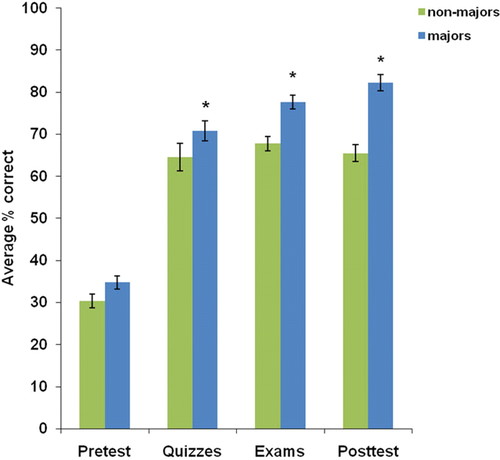
Figure 1. Comparison of common content assessments between the nonmajors and majors genetics courses. Students were assessed at different time points during the semester by using identical multiple-choice questions. The average percentage correct for each assessment is shown for each group of students (error bars show the SEM). Majors significantly outperformed nonmajors on quizzes, exams, and on the posttest (*, t test, p < 0.05). There were 16 shared questions on the pre- and posttest (GCA), 21 shared quiz questions, and 23 shared exam questions.
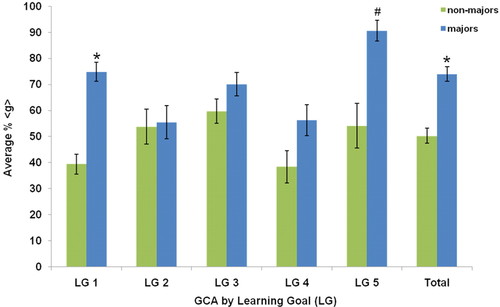
Figure 2. Average percentage of normalized learning gains from the pre- and postassessment (GCA) for each of the common learning goals (LGs). Normalized learning gain, <g>, is calculated using the formula 100(post − pre/100 − pre). The GCA assesses LG 1 with five questions, LG 2 with two questions, LG 3 with five questions, LG 4 with three questions, and LG 5 with one question. Error bars show the SEM (*, t test, p < 0.05; #, binomial distribution SE of the mean, p < 0.05).
In comparing the progression of learning for nonmajors and majors, we found that the majors show steady improvement in their performance from pretest to quiz to exam to postassessment, whereas nonmajors improve their performance at quiz time (immediately after completing an activity on the topic) but then fail to continue improving on exams or the posttest (Figure 1; see below for more on quiz and exam performance).
When the data are broken down by learning goal (Figure 2), the <g> for learning goals 1 and 5 on the GCA (Table 1) differed significantly between majors and nonmajors (t test, p < 0.05). Learning goal 1 is the most fundamental of the learning goals, and the goal upon which the rest of the course is dependent. Learning goal 5 is assessed with only one question on the GCA, in which students have to interpret a pedigree and molecular marker data to track a disease trait. Majors had higher <g> for learning goals 3 and 4 as well, but these differences were not statistically significant (t test, p > 0.05 in both cases).
Quizzes and Exams. Performance on identical shared questions captured student performance immediately after learning material in group problem-solving sessions (ungraded quizzes) and then again after studying the material (graded exams). Overall, majors performed significantly better than nonmajors on quiz and exam questions (Figure 1; t test, p < 0.05). When the quiz performances are broken down by learning goal (Figure 3), the largest difference between majors and nonmajors is again seen on learning goal 1 (t test, p < 0.05). On shared exam questions (Figure 3), majors significantly outperformed nonmajors on questions addressed in all learning goals except learning goal 4 (Table 1; t test, p < 0.05).
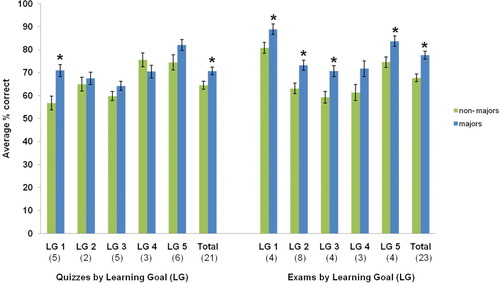
Figure 3. Average percentage correct on shared quiz and exam questions calculated for each learning goal (LG). The number of shared questions is shown in parentheses beneath each learning goal. Error bars show the SEM (*, t test, p < 0.05).
Approaches to Learning
Demographics and Previous Preparation. On the beginning-survey, we asked students to report their gender, year in school, major, genetics background, and, for nonmajors, their reason for taking the course (Table 2). The results of this survey suggest that the majors have more previous course work in genetics and have taken more university-level credit hours.
| Nonmajors (n = 72a) | Majors (n = 77a) | |
|---|---|---|
| Gender, % | 62.7 female | 60.6 female |
| Yr, % | 77.8 | 48.5 |
| Freshmen and sophomore | Freshmen and sophomore | |
| Major, % | 6 biology | 62.5 biology |
| Genetics, % | 25 | 98 future biology- related career |
| Background, % | Never taken any genetics | 7.2 never taken any genetics |
| Reason for taking course, % | 70.5 fulfill science distribution | N.A. |
| 83.6 sounded interesting |
Motivation and Attitude. In the beginning-survey, we also asked students to rate their level of intimidation, motivation, and interest with regard to the subject of genetics (Figure 4). The majors rated all three of these significantly higher than did nonmajors (Wilcoxon rank sum test, p < 0.05 in all cases).
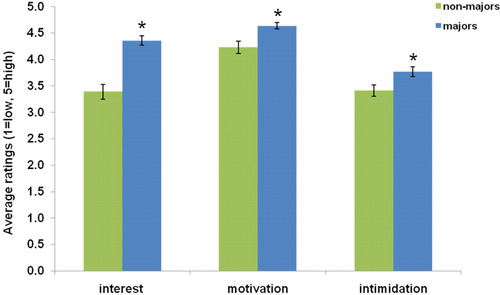
Figure 4. Differences in nonmajors' and majors' attitudes at the beginning of the course. Students ranked how interested they were in the genetics course, how motivated they were to study for this course, and how intimidated they were by the course material on a scale from 1 = low to 5 = high. Majors were significantly more interested, more motivated, and more intimidated than nonmajors. Error bars show the SEM (*, Wilcoxon rank-sum test, p < 0.05).
Grades. Students in both classes had similar grade expectations. When asked on the end-survey “When you began this course, what grade did you hope to earn?,” 78% of majors and 69% of nonmajors initially hoped to get an “A” in the course. When asked on the same survey “Now what grade would you be satisfied with?,” 42% of majors and 19% of nonmajors reported they would be satisfied with “A's”, whereas 17% of majors and 27% of nonmajors reported they would be satisfied with “C's” (a category initially chosen by zero majors). When students in the nonmajors class were asked to describe why they would now be satisfied with a lower grade, 34 of 45 (76%) reported that the course was much harder than expected and admitted to not studying enough.
We also measured students' perceived relationship between grades and understanding. When asked on the end-survey to compare the importance of their grade in the class versus understanding the content (grade more important, grade and understanding equal, or understanding more important), the most common answer for both groups was that grade and understanding were equally important. However, more nonmajors than majors reported that their grade was more important than understanding the content (Wilcoxon rank sum test, p < 0.05).
Process of Learning. In both classes, there was considerable emphasis placed on students working together. The instructors of both classes encouraged students to talk to one another during clicker questions using the peer instruction method (Mazur, 1997). The activities in group problem-solving sessions were also designed to encourage students to work together; students were instructed to check each other's work and explain concepts to one another rather than relying on the teaching assistant (TA). Both nonmajors and majors mostly agreed with the statement that they enjoyed working with their peers to solve problems and reported being comfortable asking questions of each other and the TAs. When we explicitly asked students on the midsurvey to characterize how they worked with fellow students, the self-reports on behavior were not different between the majors and nonmajors: the majority of students felt that they considered peer's answers before deciding on their own answer and reported that they would point out flaws in reasoning and question each other in these group settings. However, when we observed how the students interacted with each other during group problem solving, we found that their actual behaviors differed. For both majors and nonmajors, we observed students working together during a 50-min problem-solving session on four different occasions. In these observation periods, the students were instructed to ignore the observer, who sat off to the side of the group. Students in the nonmajors class were more than twice as likely as majors to ask questions of the TAs rather than using their peers as resources (nonmajors asked on average 4.25 questions of the TA during a session, whereas majors asked on average 1.75). We did not specifically quantify the different ways that students might interact with each other. However, every time we observed nonmajors, we saw at least one student writing down answers supplied by someone else in the group who seemed knowledgeable without asking for clarification. We never observed this behavior with the majors.
We also characterized how students in both classes reported studying for genetics (midsurvey). Not surprisingly, all students reported reading their lecture notes in preparation for exams, and the majority did so only in studying for the exams, rather than reviewing them immediately after class. We also asked them to rate on a scale of 1 (never) to 5 (always) how frequently they reworked clicker questions, problems from activities, and homework questions before exams (Figure 5). More than half of the students in both classes reported always or almost always reworking problem-solving activities and clicker questions before exams. However, majors reported reworking their homework significantly more frequently than did nonmajors (Wilcoxon rank sum test, p < 0.001). To account for possible changes in behavior by the end of the semester, we asked on the end-survey whether they used any of these techniques more or less in the second half of the semester. There was no significant change in how students reported studying in either class (data not shown).
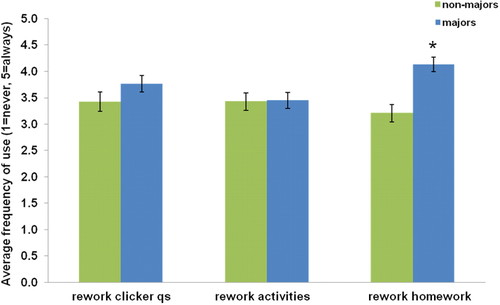
Figure 5. Comparison of different study strategies for majors and nonmajors. Students rated the frequency (1 = never, 5 = always) with which they reworked their homework, clicker questions, and problem-solving activities. Majors reworked their homework significantly more than nonmajors but did not significantly differ in their other study strategies. Error bars show the SEM (*, Wilcoxon rank-sum test, p < 0.001).
Time Spent Studying. In addition to differences in study habits, there were differences in the amount of time the two populations of students spent outside of class working on genetics. In an attempt to increase the reliability of self-reporting on time spent studying, we surveyed students shortly after they completed every homework assignment. At the end of each electronically submitted homework, students reported how much time they spent studying for the class that week in addition to completing the homework assignment (<2–>5 h). In the class period after each exam, we surveyed the students anonymously by clicker on time spent studying for the exam (<2–>5 h). Majors reported spending significantly more time studying for the class and studying for the exams than nonmajors (Figure 6; Wilcoxon rank sum test, p < 0.001).
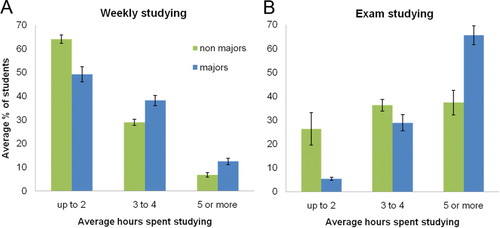
Figure 6. Study time comparison between nonmajors and majors. (A) Average time spent studying per week, outside of time spent working on the homework assignments (self-report, at end of each homework assignment). Majors reported spending significantly more time studying for the class (Wilcoxon rank sum test, p < 0.001). (B) Average time spent studying for each exam based on anonymous self-reporting in the class period after each exam (three exams, each course). Majors reported spending significantly more time studying for exams. (Wilcoxon rank-sum test, p < 0.001). Error bars show the SEM.
We imagined that nonmajors and majors might have different reasons for why they study more or less for their genetics course, depending on the rest of their course load that semester. We asked students on the midsurvey to rate their genetics course compared with the other courses they were currently taking with regards to studying, difficulty, importance to career, and interest level by assigning it a number out of the total number of courses they were taking. Both majors and nonmajors gave their genetics course a high (and similar) rank for time they spent studying and the difficulty of the course (Table 3). However, majors ranked their genetics course significantly higher in terms of interest level and importance to future career (t test, p < 0.05).
| Time studying | Difficulty | Importance to career | Interest level | |
|---|---|---|---|---|
| Majors | 0.68 (0.03) | 0.70 (0.04) | 0.74 (0.04)* | 0.80 (0.03)* |
| Nonmajors | 0.66 (0.03) | 0.73 (0.04) | 0.37 (0.04)* | 0.62 (0.04)* |
Measuring Attitudes toward Biology: the BioCLASS. We used the BioCLASS to determine students' perceptions about studying and learning biology. We administered the BioCLASS in the first and last weeks of class as part of the beginning- and end-surveys, and then we calculated an overall average percentage of agreement with more than 80 experts who responded to the identical statements. Figure 7 shows the average percentage of agreement with experts in each of seven categories, as well as the change in agreement with experts from pre- to postassessments. If students respond to statements in the same way experts respond to statements, they have a high percentage of agreement score on the CLASS. Nonmajors begin and end the course with a significantly lower overall percentage of agreement than majors (two-tailed t test, p < 0.0001). Within individual categories, nonmajors have both small negative and small positive shifts in attitude, although none is significantly different from zero (two-tailed t test, p > 0.1). Their largest positive shift is in problem-solving strategies. Majors start out with a higher percentage of agreement with experts, remain at the same overall level by the posttest, and show both positive and negative shifts that are not significantly different from zero in individual categories (two-tailed t test, p > 0.1). Overall, both majors and nonmajors stay relatively novice or expert in their beliefs, regardless of the material presented in the course.
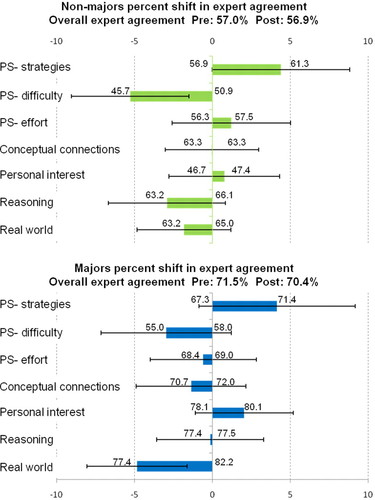
Figure 7. Percentage of agreement with experts and percentage of shift (post and pretest) for each of the seven categories measured by the BioCLASS. The percentage of change in agreement with experts is shown for each category in the BioCLASS. Pre- and postpercentage of agreement with experts is also shown for each category, on either side of the shift. There are both positive and negative shifts for nonmajors and majors, but neither of the groups makes a significant change in their attitudes toward biology in any category (two-tailed t test, p > 0.05). Also shown is the average overall percentage of agreement with expert views for students in each course, both pre and posttest. PS, problem solving. Error bars show the SEM.
Effects of Class Standing. Because the two courses had different distributions of underclassmen (freshmen and sophomores) and upperclassmen (juniors and seniors; Table 2), we also compared the effect of grade level on student performance and attitudes. In the majors course, we found no significant effect of grade level on GCA learning gain, exam performance, or attitudes (data not shown). However, in the nonmajors course, there were differences between the upperclassmen and underclassmen. As a group (n = 16), these upperclassmen nonmajors performed significantly better than the underclassmen nonmajors (one-factor analysis of variance [ANOVA], Tukey post hoc test, p < 0.05) and as well as the majors students (one-factor ANOVA, Tukey post hoc test, p > 0.05), both in terms of GCA learning gains and exam performance. However, the upperclassmen nonmajors do not study more than the rest of the nonmajors nor are they more motivated, intimidated, or interested (Wilcoxon rank sum test, p > 0.05 in all cases). On the BioCLASS, the upperclassmen nonmajors began the class with a nonsignificant but lower overall percentage of agreement with experts than the underclassmen nonmajors (51% compared with 57%), but they showed a significant positive increase (two-tailed t test, p < 0.05) in their attitudes up to 61% by the end of the course. Thus, the upperclassmen nonmajors had the only significant overall positive shift in attitudes when compared both to the rest of the nonmajors and the majors.
DISCUSSION
In this article, we have characterized the differences in performance and attitudes between students taking a genetics course designed for science majors and students taking a genetics course designed for nonscience majors. Our data indicate that although nonmajors and majors begin their genetics courses with the same level of conceptual knowledge (GCA pretest), majors outperform nonmajors on quiz, exam, and GCA posttest questions (Figure 1). We show that majors begin their course with higher levels of motivation and interest (Figure 4) and report studying more and studying more effectively by reworking homework problems in addition to clicker questions and activities (Figures 5 and 6). We also observed that majors are more likely to question their peers and engage more fully in group work than nonmajors. Finally, majors have more expert beliefs about studying and learning biology (Figure 7) and see a stronger connection between their genetics course and their future careers (Table 3). These results suggest that student performance is affected by their approach and attitude toward genetics.
From their common wrong pretest answers on the GCA, it is clear that majors and nonmajors begin the semester with similar incorrect ideas about genetics (data not shown). The problem-solving activities and postactivity quizzes were specifically designed by the authors to address known problems in how students understand genetics. Working on these activities and taking the quizzes was intended to give students extra practice applying fundamental concepts to new situations (application, or transfer) and in-class testing opportunities, a technique shown by cognitive psychologists to improve retention (Karpicke and Roediger, 2008). When broken down by learning goal, we found that majors and nonmajors performed similarly on postactivity quiz questions, except on learning goal 1 (Figure 3), but only majors went on to improve their performance on exam and GCA posttest questions (Figure 1). These results suggest that in-class learning alone was insufficient to prepare students for exams; therefore, it is likely that additional studying between the end of an activity and the exam helped majors reach a higher level of understanding. Accordingly, majors reported studying (Figure 6) and reworking their homework problems more (Figure 5). In reworking the homework problems, majors were using a technique of “deliberate practice,” which has been shown to be more valuable than rote memorization for improving conceptual understanding (Ericsson, 2006), especially in the context of feedback such as comparing the correct answer with their own (Gibbs and Simpson, 2004).
The only learning goal where the nonmajors significantly underperform the majors on quizzes, exams, and GCA learning gains is learning goal 1: “Deduce information about genes, alleles, and gene functions from analysis of genetic crosses and patterns of inheritance.” (Figures 2 and 3). The consistently low performance of nonmajors on this learning goal suggests that nonmajors struggle with the most fundamental learning goal in the course. Although the concepts addressed in learning goal 1 are interwoven through both courses, the majors use more difficult examples and extend these concepts more in homework assignments and exam questions as the course progresses, because their course material is unquestionably more detailed (Supplemental Material A and B). Majors may ultimately demonstrate better understanding of learning goal 1 concepts than nonmajors because majors are forced to grapple with the concepts at a deeper level during the course. As suggested in Ericsson (2006), the repeated use and practice of basic concepts of learning goal 1 may give the majors a more expert-like way to approach questions on this goal as well as questions on related goals.
Another important factor in student performance is attitude. In this respect, the two groups were clearly different. As a group, the nonmajors were less interested in genetics, found it less relevant to their future career, and were less motivated to study (Table 3 and Figure 4). Surprisingly, they also reported being less intimidated by the subject of genetics than the majors. If nonmajors began the course expecting it to be easy, they may have set a relatively low bar for themselves in terms of study time and engagement. The majors who participated in the coseminar, in contrast, were more intimidated about the course and their ability to perform well, potentially encouraging them to work harder. Their desire to perform well was almost certainly influenced by their interest level and the importance of the class to their future careers. A study by Jensen and Moore (2008) lends further support to our finding that student attitudes are related to performance. These authors showed that students who ultimately earn an “A” in an introductory biology course have different behaviors throughout the course than the students who earn lower grades. The high-performing students steadily improve their exam scores over the semester, and are more likely to attend class and submit extra-credit work, whereas the low performers show a steady decline in exam scores and become less likely to be fully involved in the course. This behavior pattern suggests that students' initial attitudes, participation, and study habits are critical for their ultimate performance in the class.
Differences in attitudes were also evident in our observations of how students interacted during problem-solving sessions. Majors were more engaged in the activities—they discussed their answers, argued about what made sense, and took turns explaining their reasoning to each other. Nonmajors, working on the same activities, tended to look for the right answer rather than search for a deeper understanding, and frequently gave up, relying on the instructor or TAs to provide them with the correct answers. These behaviors are typical of students with more novice attitudes about science and are also reflected in the results from the BioCLASS attitude survey (Figure 7). Nonmajors are overall significantly more novice in how they learn and think about biology than are majors. Moreover, nonmajors have a particularly low percentage of agreement with experts at both the beginning and end of the course in the areas of problem-solving difficulty, problem-solving effort, and personal interest. They do not necessarily find the study of biology enjoyable, nor see the topics as directly connected to their lives. The relatively novice views of the nonmajors probably impact how they interact with the course materials, thereby also affecting their study habits. Interestingly, neither nonmajors nor majors show a significant decline in the level of their beliefs by the end of the semester, as is typically seen in traditionally taught introductory physics courses (Perkins et al., 2005). This result suggests that the more interactive format of both courses may help to prevent the shift toward more novice attitudes, as has also been shown in physics (Brewe et al., 2009).
Time on Task
We cannot rule out the possibility that additional class time on task contributes to the improved performance of the majors. The majors had one additional hour per week of exposure (in the coseminar) to the course material than did the nonmajors, and 67% of these majors were also enrolled in a 2-h weekly lab. However, we do not believe that additional class time on task can solely account for the improved performance of majors for the following reasons: 1) Majors not enrolled in the coseminar, who did not have an additional hour of problem solving, performed at a similar level to majors enrolled in the coseminar. Thus, although the coseminar may be beneficial to the students, it cannot be the only factor affecting performance. 2) Majors and nonmajors perform similarly on the quizzes that immediately follow problem-solving activities addressing learning goals 2–5 (Figure 3). If the additional hour of contact time in the coseminar was solely responsible for increased performance, one would expect to see a difference in quiz performance on all learning goals, not just learning goal 1. 3) The content of the accompanying majors lab course overlaps with the content of questions analyzed in this study only for learning goal 3, and majors outperform nonmajors on this learning goal only on exams (Figure 3). If the laboratory course had a large influence on student performance, we would also expect to see significant learning goal 3 performance differences on quizzes and learning gain on the GCA (Figures 2 and 3). Also, several lines of evidence suggest that students' experience in separate, traditional laboratory courses does not aid their understanding of classroom material (for reviews, see National Research Council [NRC] (2005) and Hofstein and Lunetta (2004)). Because we did not set out to test the effects of a laboratory on understanding of course material or on the attitudes of the students, we cannot completely address the effect that the laboratory experience may have on student learning.
Effects of Class Standing on Performance
We remain puzzled by the finding that upperclassmen in the nonmajors course show equivalent exam scores and GCA learning gains compared with students in the majors course. The upperclassmen nonmajors did not study significantly more or differently from the other nonmajors, and they did not begin the course with more expert ideas about science than other nonmajors. In fact, the upperclassmen nonmajors have the lowest percentage of agreement with experts on the pre BioCLASS, but make the largest gains in percent agreement with experts by the end of the course (61% overall agreement; positive shifts in each category). This positive attitude shift in the upperclassmen nonmajors is the only difference we measured that may have impacted their performance in the course. One possible additional explanation for their high performance is that the upperclassmen nonmajors may have been more receptive to the format of the course because of various experiences in other university courses. Another possible interpretation is that this group is simply too small to be adequately representative; this group of 16 nonmajors included three students who were declared biology majors in another Biology Department on campus (Integrative Physiology). Among the rest of the 56 students in the nonmajors class, there were only three additional students considering majoring in biology. Thus, although the effect of class standing on performance may be an interesting topic for future study, it is probably not relevant in this study.
CONCLUSIONS
Both majors and nonmajors in this study made learning gains in genetics content. Although we have demonstrated that nonmajors do not always achieve as high a level of understanding as majors, we suggest that the way to address this disparity is by focusing on changing student attitudes rather than focusing more on content. Our data are consistent with the idea that prior experience with biology, attitude, study time, and study techniques can impact performance. Majors, who have taken more biology, and plan to use biology in the future, are likely to have a more established framework of biology concepts. These students may be better able to connect new ideas to previous concepts, thus expanding and building on their mental models. Nonmajors, in contrast, are more likely to have disconnected collections of concepts that they have trouble connecting together into a “big picture” view. In future nonmajors courses, we plan to focus on the process of doing and evaluating science, and connecting each concept to real-world applications (media stories, potential impacts on their lives) to see whether these approaches are more successful in encouraging nonmajors to change their attitudes about biology and their approaches toward learning biology. If, as suggested by Wright (2005), the course is perceived as interesting and important to their future, nonmajors may become more motivated and engaged in the process of learning genetics and thus possibly study more effectively and more often. These kinds of changes in approach are likely to stimulate majors as well, but for nonmajors, they could make an essential difference in how these students view and understand biology.
ACKNOWLEDGMENTS
We thank Wendy Adams, Carl Wieman, and William Wood for valuable comments on the manuscript, other members of the Science Education Initiative and other science educators on campus for feedback over the course of the project, and the students of these classes for willingness to participate in this research. The Science Education Initiative at the University of Colorado supported M.K.S. (full) and J.K.K. (partial) for this study.


